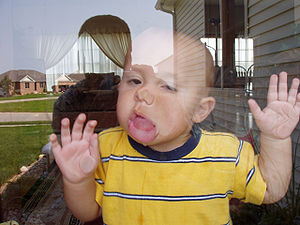 Image via Wikipedia
Image via WikipediaI knew about the classic work of Meltzoff and colleagues on neonatal imitation, but I'd struggled to see evidence of that kind of very early imitation in my own kids. Meltzoff's findings have not always been replicated, and when they are, they seem to require certain very specific experimental conditions to be in place. But it's also interesting that neonatal imitation has been suggested to be a kind of innate reflex that disappears quite soon after birth, only to re-emerge a couple of months later when more sophisticated, cortical brain systems take over responsibility. That's probably why parents don't usually see imitation until babies are a couple of months old. There were several times when I thought Athena was imitating a smile in the first few weeks, but I wasn't really convinced that it was happening until she was about seven weeks.
The starting point for the radio piece was the story I blogged about a few weeks ago, on newborns' ability to 'cry in' their own accent. I wanted to make the point in the interview that what's special about these findings is that they show that babies are capable not just of picking up information in the womb, but of using that knowledge to shape their own behaviour. They don't just learn the accent; they reproduce it for themselves. Imitation gets really clever when it works at a distance: when the mimicking is produced some time after the initial stimulus is perceived. We call this 'deferred imitation', and it really gets going in babies from after around six months.
A professional mimic is, of course, an expert in deferred imitation, and the comedienne Jan Ravens unsurprisingly stole the show with some very funny take-offs. But toddlers' imitation can be even more sophisticated. Babies and young children don't just imitation actions; they also imitate intentions. Some of the most interesting recent imitation research shows that children will copy what they thought an adult was trying to do, rather than what she actually did do. For example, a toddler watches a scenario where an adult is trying to drop a ping-pong ball into a cup. The adult misses the cup, and the ball bounces off the side of the cup and onto the table. What will the toddler do when given these materials? She will drop the ball straight into the cup. She will copy what she thought the grown-up was trying to do, rather than what she actually succeeded in doing.
There's also some great new research on over-imitation. This is where children don't just copy the actions that are essential to producing an effect; they will also copy extraneous additional actions which they seem to judge are important. For example, an adult shows a child how you can make a box make an interesting sound by pressing a button on the top. He then proceeds to press the button and elicit the sound, but not before tracing three completely pointless circles in the air above the box. The toddlers copy the button-pressing, but they also copy the irrelevant actions that precede it. Chimpanzees, in contrast, don't bother with all the fancy stuff; they just get on and press the button. It's as though the human children also want to imitate the adult's full set of intentions (the irrelevant actions as well as the relevant ones), rather than just the basic cause-and-effect.
There's plenty more that could be said about this complex and fascinating area of research, but for the moment here's the link to the show.
![Reblog this post [with Zemanta]](http://img.zemanta.com/reblog_e.png?x-id=d610e6c2-a070-4a89-a363-1326d1aa64ac)





I listened to this when it went out and it was fascinating. To think that newborn babies can imitate their parents' faces within hours, and cry in different languages. Really interesting.
ReplyDelete